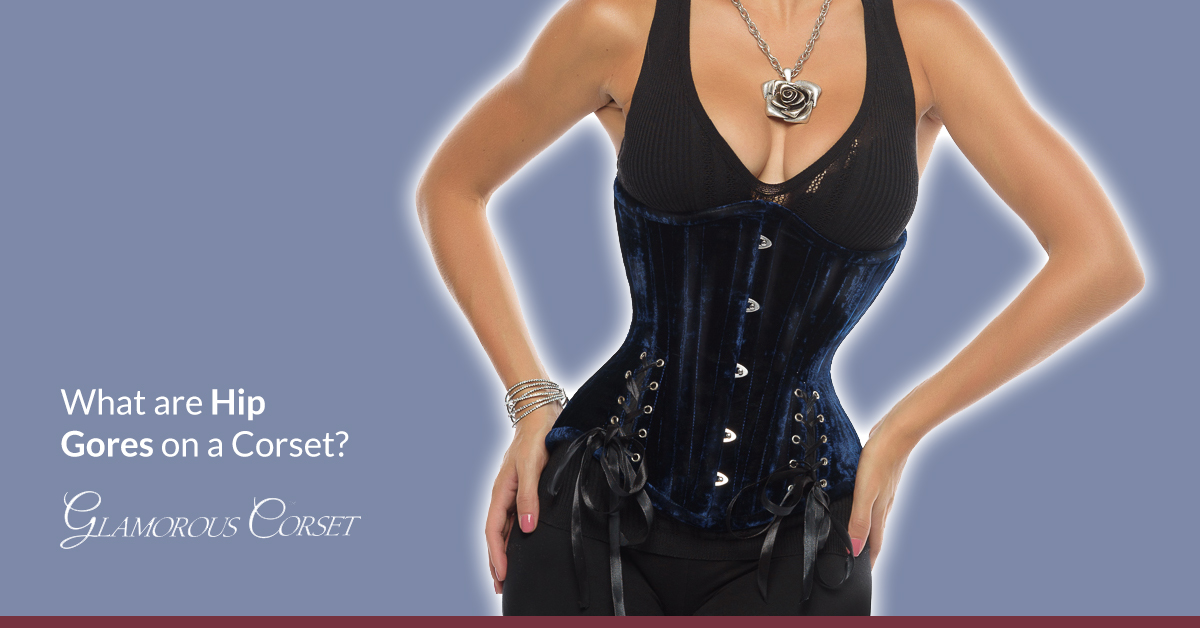Blog
What are Hip Gores on a Corset?
Featured Corset: Lara Navy Blue Velvet Corset w/ Hip Ties
When you think of gore, you probably envision blood-soaked horror films like Saw or the Evil Dead. While some of us get squeamish at the sight of all that red-tinted corn syrup, others live for the camp and grotesquerie.
Regardless, you don’t want a lot of gore in your wardrobe. You’re not living in Grimm’s Fairy Tales, where you have to cut off a toe to make the glass slipper fit.
At this point, you’re probably wondering what gore has to do with corsetry. In garment design, gores can actually be a good thing for achieving the best fit. What are hip gores, and how could they improve your corset?
In this article:
- What Are Hip Gores on a Corset?
- Benefits of Hip Gores
- How Can I Add Hip Gores?
What Are Hip Gores on a Corset?
If you’ve ever seen a clothing pattern, you may have noticed it was flat. However, our bodies aren’t even close to flat—they have all kinds of curves. This is why sewing patterns also tend to include a range of markings that help you create curves.
You’re probably familiar with pleats, which are fabric folds that make a specific part of a garment smaller to create a corresponding flair. Darts do the same thing, but with a cutout instead of a fold, to create a flat seam.
There are also tricks to create more space in a garment, such as adding a gusset or gore. The two are similar, but where a gusset is a piece of fabric typically inserted at a seam to allow for more movement (as in under the arm or in the crotch), a gore is a triangular piece of fabric meant to add fullness.
A hip gore is usually placed at the side of the body along the bottom edge of the corset (the outside of the hip) to expand the bottom portion of the garment. This also increases the spring—the ratio between the waist circumference and the lower edge of the corset, or the relative curve of the garment from waist to hip.
Benefits of Hip Gores
If you’ve ever worn a corset that’s comfortably snug at the waist but impossibly tight in the hip, you’ll instantly understand the advantage of adding gores, which create more space at the hip.
Even if your corset fits well when you first season it, you may find it feeling tighter at the hip over time as you progress through your waist training journey and significantly decrease your waistline.
Anyone with a small waist and larger hip circumference may want to add gores to existing corsets. You can also look for models who already include them to accommodate a curvy physique and the desire for greater spring in the garment.
How Can I Add Hip Gores?
Unless you have some experience in corset tailoring, it’s not a great idea to add your own gores. You can certainly cut into a seam or panel to add extra fabric, but keep in mind that corsets are designed to perform under incredible tension.
When you cut into them, there’s always a chance you’ll compromise the strength and integrity of the garment, impacting performance. For this reason, it’s best to take your corset to a skilled tailor, ideally one who has experience with corsetry.
To stay up-to-date with weekly blog posts, waist training tips, and the chance to win one of our monthly corset giveaways, follow us on Facebook, Instagram & subscribe to our mailing list today! Want to find the perfect steel boned corset? Shop some of our favorites: underbust corsets, overbust corsets, corset dresses. You can also shop our corsets by material: cotton corsets, denim corsets, leather corsets, mesh corsets, pvc corsets, and satin corsets. Have questions about getting started with waist training or finding the right size corset? Contact us!

My name is Rachel, I am the owner of Glamorous Corset, a small business founded by me in 2010. Back In 2005, I was in a car accident that left me with a herniated disk. Much to my surprise I learned steel boned corsets were beneficial to several medical injuries including mine. I was always intrigued with corsetry, their history and their beautiful aesthetic. I love sharing knowledge about corsets, educating my wonderful readers and breaking the negative stigma related to corsetry. In combination with my years of research and personal experience I hope my articles are useful and can help anyone who has struggled with some of the same things I have. More about me…


